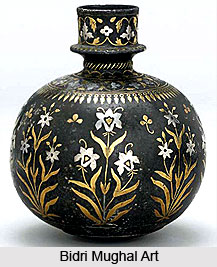 Mughal Art had first cast its spell in areas like Hyderabad, Deccan, in the centre of India. The monumental splendours of Delhi and Agra are worth noticing and they are a part of the Mughal Art. The ways were old-fashioned with enchanting pillared halls and with shady courtyards and fountains. It has been said that the Mughal Art was very elegant and the artists of this era were very skilful.
Mughal Art had first cast its spell in areas like Hyderabad, Deccan, in the centre of India. The monumental splendours of Delhi and Agra are worth noticing and they are a part of the Mughal Art. The ways were old-fashioned with enchanting pillared halls and with shady courtyards and fountains. It has been said that the Mughal Art was very elegant and the artists of this era were very skilful.
Bidri is an important form of Mughal Art which had a pure and unadorned form. During the Mughal period the tradition of the most robust sort continued even during the Mughal period. It can be said that during the Mughal period as the floral ornament of the Muslim courts took hold, the native Indian taste for sculptural form enriched it, giving Mughal poppies and irises the rhythm and weight of goddesses.
The word "Mughal" describe objects made in India during the rule of the Muslim Mughal emperors - mainly the sixteenth to the eighteenth centuries - not to imply that they were necessarily destined for use at court. Many were made for the Hindu Rajput princes of Rajasthan or the Shia Sultans of the Deccan - the former Mughal vassals.
 The basic characteristics of Mughal art and architecture are floral motifs rendered with a profoundly Indian sense of weight and volume. Bidri, the black alloy containing mainly zinc, from Bidar in the Deccan, inlaid with copper, brass and silver, has the sombre, fabulous air present also in early Deccani School of painting. It may have been developed to rival the opulent inlaid metal wares of the medieval Middle East. The gold enamels of the Mughal Period are finer. Their shapes are more elegant and graceful and their colours infinitely more delicate and varied.
The basic characteristics of Mughal art and architecture are floral motifs rendered with a profoundly Indian sense of weight and volume. Bidri, the black alloy containing mainly zinc, from Bidar in the Deccan, inlaid with copper, brass and silver, has the sombre, fabulous air present also in early Deccani School of painting. It may have been developed to rival the opulent inlaid metal wares of the medieval Middle East. The gold enamels of the Mughal Period are finer. Their shapes are more elegant and graceful and their colours infinitely more delicate and varied.
The two fold style that was prevalent in India before Mughal Art flourished were the local style connected with the production of Hindu and Buddhist sculpture; the other employed a deliberately Islamic idiom. This style was present in the country during the 16th and 17th centuries. Mughal Art in India to large extent has been influenced by the Persian style and the style of Sindh.
About Mughal Art it can be said that the Sultanate age produced architecture of the highest order. Some of the few characteristics of the Mughal Art were Sultanate metalwork never imitates Middle Eastern styles. These are also a strong emphasis on horizontal lines, in the tradition of medieval Hindu temples in India and the massive, ground-hugging architecture.
The casket of the Mughal period has the pronounced sloping walls and very low dome of Sultanate architecture; moreover, the outline of the two war elephants on its face conform to the traditional Indian configuration of this animal rather than to the Persian. The shape of the flask is of a type which so far remains unknown in the repertoire of Middle Eastern metalwork.
The Hindu sculptural tradition survived at the courts of Muslim Sultans chiefly in the form of splendid metal vessels, mainly incense burners and aquamarines, in the shapes of birds and lions.






































